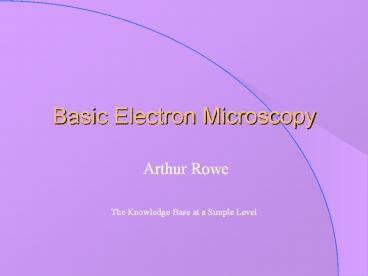Basic Electron Microscopy - PowerPoint PPT Presentation
Title:
Basic Electron Microscopy
Description:
Basic Electron Microscopy Arthur Rowe Basic Electron Microscopy Arthur ... requirements for imaging macromolecules aids such as gold-labelled antibodies the ... – PowerPoint PPT presentation
Number of Views:578
Avg rating:3.0/5.0
Title: Basic Electron Microscopy
1
Basic Electron Microscopy
- Arthur Rowe
The Knowledge Base at a Simple Level
2
Introduction
- These 3 presentations cover the fundamental
theory of electron microscopy - In presentation 3 we cover
- requirements for imaging macromolecules
- aids such as gold-labelled antibodies
- the negative staining method
- the metal-shadowing method
- Including high-resolution modifications
- vitritied ice technology
- examples of each type of method
3
requirements for imaging macromolecules
- sufficient CONTRAST must be attainable, but
- gt bio-molecules are made up of low A.N. atoms
- gt are of small dimensions (4 nm)
- gt hence contrast must usually be added
- sufficient STABILITY in the beam is needed
- gt to enable an image to be recorded
- gt low dose random imaging mandatory for any
- high resolution work
4
ways of imaging macromolecules
- ADDING CONTRAST (with heavy metals)
- gt negative contrast
- computer analysis
- immunogold labels
- gt metal shadowing
- computer enhancement
- USING INTRINSIC CONTRAST
- gt particles in thin film of vitrified ice
- computer acquisition processing
5
ways of imaging macromolecules
- using immunogold labels to localise epitopes
- gt widely used in cell biology
- gt beginning to be of importance for
macromolecules
Au sphere Mab epitope
macromolecule
6
negative staining
particles
Electron dense negative stain
7
negative staining
- requires minimal interaction between particle
stain - to avoid binding, heavy metal ion should be of
same charge /- as the particle - positive staining usually destructive of
bio-particles - biological material usually -ve charge at
neutral pH - widely used negative contrast media include
- anionic cationic
- phosphotungstate uranyl actetate/formate
- molybdate (ammonium) (_at_ pH 4)
8
metal shadowing - 1-directional
9
metal shadowing - 1-directional
- Contrast usually inverted to give dark shadows
- gt resolution 2 - 3 nm - single 2-fold a-helix
detectable - - historic use for surface detail
- - now replaced by SEM
- gt detail on shadow side of the particle can be
lost - gt apparent shape can be distorted
- gt problems with orientation of elongated
specimens - - detail can be lost when direction of
- shadowing same as that of feature
- gt very limited modern use for macromolecular work
10
metal shadowing - rotary
11
metal shadowing - rotary
- Contrast usually inverted to give dark shadows
- gt resolution 2 - 3 nm - single DNA strand
detectable - - historic use for molecular biology
- (e.g. heteroduplex mapping)
- gt good preservation of shape, but enlargement of
- apparent dimensions
- gt in very recent modification (MCD -
microcrystallite - decoration), resolution 1.1 nm
12
particle in vitrified icelow contrast
particle
particles examined at v. low temperature, frozen
in a thin layer of vitrified (structureless) ice
- i.e. no contrast added
13
particle in vitrified icelow contrast
average of large numbers (thousands ) of very
low contrast particles enables a structure to be
determined
14
particle in vitrified icelow contrast
- average of large numbers (thousands ) of very
low contrast particles enables a structure to be
determined - resolution may be typically 1 nm or better
- this is enough to define the outline (or
envelope) of a large structure - detailed high resolution data give us models for
domains (or sub-domains) which can be fitted
into the envelope - ultimate resolution of the method 0.2 nm,
rivalling XRC/NMR
15
particle in vitrified icethe ribosome
16
particle in vitrified icephage T4 rotavirus
17
case study GroEL-GroES
- important chaperonins
- hollow structure
- appear to require ATP (hydrolysis ?) for
activity
18
particle in vitrified icelow contrast
the chaperonin protein GroEL visualised in
vitrified ice (Helen Saibil co-workers)
19
GroEL GroEL ATP GroELGroES
ATP
20
(No Transcript)
21
GroEL GroEL ATP GroELGroES
ATP
22
(No Transcript)
23
case study pneumolysin
53 kD protein, toxin secreted from
Pneumococcus pneumoniae among other effects,
damages membrane by forming pores major
causative agent of clinical symptoms in
pneumonia
24
electron micrographs of pores in membranes
caused by pneumolysin
RBC / negative staining
membrane fragment metal shadowed
25
Pneumolysin Homology model based upon the known
crystallographic structure of Perfringolysin
26
Pneumolysin - homology model domain 3, fitted
to cryo reconstruction
27
Pneumolysin - EM by microcrystallite decoration
(MCD) reveals orientation of domains
28
Pneumolysin - monomers identified within the
oligomeric form (i.e. the pore form)
29
case study myosin S1
motor domain of the skeletal muscle protein
myosin 2 S1s / myosin, mass c. 120 kD
cross-bridge between myosin and actin
filaments, thought to be source of force
generation
30
myosin is a 2-stranded coiled-coil protein, with
2 globular (S1) heads
S1 unit
31
Each S1 unit has a compact region, a lever
arm connected via a hinge to the main extended
tail
32
Myosin S1 imaged by Microcrystallite Decoration
(no nucleotide present)
33
Effect of nucleotide (ADP) on the conformation of
myosin S1 as seen by MCD electron microscopy
-ADP
ADP
34
case study epitope localisation in an
engineered vaccine
a new vaccine for Hepatitis B contains 3
antigens, S, S1 S2, with epitopes on each but
does every particle of hepagene contain all
3 of these epitopes ? Mabs against S, S1 S2
have been made conjugated with
gold S 15 nm S1 10 nm S2 5 nm
35
immunolabelling of one epitope (S1) in hepagene
using 10 nm-Au labelled Mab
36
triple labelling of 3 epitopes on hepagene
37
Basic Electron Microscopy
- Arthur Rowe
End































